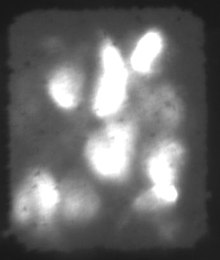
A field-emission display (FED) is a flat panel display technology that uses large-area field electron emission sources to provide electrons that strike colored phosphor to produce a color image. In a general sense, an FED consists of a matrix of cathode-ray tubes, each tube producing a single sub-pixel, grouped in threes to form red-green-blue (RGB) pixels. FEDs combine the advantages of CRTs, namely their high contrast levels and very fast response times, with the packaging advantages of LCD and other flat-panel technologies. They also offer the possibility of requiring less power, about half that of an LCD system. FEDs can also be made transparent.[1]
Sony was the major proponent of the FED design and put considerable research and development effort into the system during the 2000s, planning mass production in 2009.[2] Sony's FED efforts started winding down in 2009, as LCD became the dominant flat-panel technology.[3] In January 2010, AU Optronics announced that it acquired essential FED assets from Sony and intends to continue development of the technology.[4] As of 2024[update], no large-scale commercial FED production has been undertaken.
FEDs are closely related to another developing display technology, the surface-conduction electron-emitter display (SED), differing primarily in details of the electron-emission system.
- ^ "CNT FED". www.teconano.com.tw. Archived from the original on 2019-12-01. Retrieved 2020-01-04.
- ^ "Sony Gets Serious With Another Next-Gen Display Tech: FED, Like CRT But Really Thin". Gizmodo. 5 July 2008.
- ^ Serkan Toto, "FED: Sony calls it quits, basically burying the technology as a whole" Archived 2009-06-19 at the Wayback Machine, CrunchGear, 31 Mar 2009.
- ^ Cite error: The named reference
AUO_FETwas invoked but never defined (see the help page).